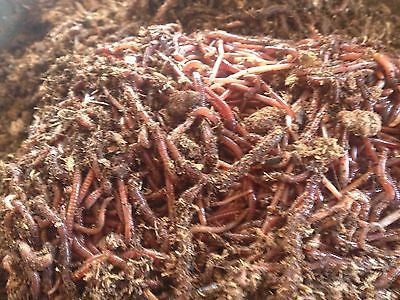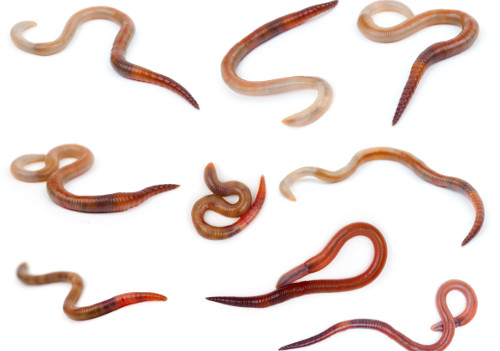Get Red Wiggler Worms - Ideal for Composting and Horticulture
Get Red Wiggler Worms - Ideal for Composting and Horticulture
Blog Article
Optimizing the Benefits of Red Wiggler Worms: A Comprehensive Handbook for Home Gardeners and Urban Farmers
In the world of sustainable gardening techniques, red wiggler worms stand as unsung heroes, quietly changing organic waste right into nutrient-rich spreadings that can work wonders for soil wellness. By checking out the intricacies of how to effectively care for and take full advantage of the benefits of red wiggler worms, individuals can open a wealth of possibilities for improving the sustainability and efficiency of their horticulture endeavors.
Understanding Red Wiggler Worms
Red Wiggler worms, renowned for their efficient composting abilities, are a species of earthworms commonly utilized in vermiculture practices. These worms, scientifically referred to as Eisenia fetida, prosper in rotting organic material, making them ideal candidates for composting (Red Wiggler Worms). Red Wigglers are starved eaters, capable of consuming their own weight in natural waste daily. Their gastrointestinal process breaks down natural issue into nutrient-rich spreadings, which are a useful resource for improving soil and promoting plant development.
One trick quality of Red Wiggler worms is their reproductive rate. These hermaphroditic animals have both women and male reproductive organs, allowing them to recreate rapidly under positive problems. A fully grown Red Wiggler can produce several children in a brief period, guaranteeing a consistent populace within a composting system.

Establishing a Worm Container
When establishing a worm container for vermiculture functions, proper prep work and focus to information are crucial for creating a conducive setting for Red Wiggler worms. Begin by selecting an ideal container for your worm bin.

Area the worm container in an awesome, dark area far from direct sunlight and extreme temperature levels. Routinely keep an eye on the moisture levels, including water if the bed linens feels dry or half-cracked. Feed the worms a balanced diet regimen of vegetables and fruit scraps, staying clear of citrus fruits, onions, and spicy foods. By following these steps, you can set up a growing worm bin that will efficiently refine natural waste into nutrient-rich vermicompost for your yard.
Feeding and Keeping Worms
Making certain a well balanced and healthy diet is vital for the wellness and efficiency of Red Wiggler worms in a vermiculture system. Red Wigglers are voracious eaters, qualified of consuming their own body weight in organic matter daily. To maintain a flourishing worm population, it is vital to supply them with a range of food scraps such as vegetables and fruit peels, coffee premises, tea bags, and crushed eggshells. It is crucial to avoid feeding them citrus fruits, onions, garlic, milk items, meat, and oily foods as these can be damaging to the worms or trigger unpleasant odors in the container.
Proper moisture levels are likewise vital for the health of Red Wiggler worms. By carefully monitoring their diet, dampness, why not check here and environmental problems, home gardeners and urban farmers can sustain a efficient and healthy and balanced Red Wiggler worm populace for composting objectives.
Gathering Worm Castings
To effectively draw out nutrient-rich worm spreadings from the vermicompost, a methodical harvesting procedure is important for taking full advantage of the composting benefits. The first step in collecting worm spreadings is to motivate the worms to move to one side of the bin.
After the spreadings have been gathered, it is essential to separate any remaining worms from the spreadings to avoid hurting them throughout storage space or application. One reliable method is to produce conical heaps of spreadings under intense light. Worms will intuitively relocate away from the light, permitting simple separation and elimination.
Lastly, the harvested worm castings ought to be stored in a trendy, dark, and completely dry place to maintain their quality and efficiency as a nutrient-rich soil modification. By following these actions, home gardeners and metropolitan farmers can make best use of the advantages of red wiggler worms in their vermicomposting systems.
Utilizing Worm Castings in Gardening
The incorporation of nutrient-rich worm castings right into yard soil can substantially boost plant development and general dirt health. Worm spreadings, also referred to as vermicast, are a natural plant food created see this page by red wiggler worms as they damage down raw material. These castings are abundant in crucial nutrients like nitrogen, phosphorus, potassium, and valuable microorganisms that advertise plant development and enhance soil structure.
When using worm spreadings in gardening, it is necessary to blend them completely right into the dirt or utilize them as a top clothing around plants. The slow-release nature of worm castings makes certain a stable supply of nutrients to plants over time, minimizing the threat of nutrient leaching and promoting long-term soil fertility. In addition, worm castings aid improve dirt oygenation, water retention, and microbial task, developing a healthy atmosphere for plant origins to thrive.

Final Thought
Finally, the use of red wiggler worms in home gardening and urban farming can considerably profit dirt health and wellness and plant development. By comprehending just how to set up and preserve a worm container, feed the worms appropriately, and collect their nutrient-rich spreadings, garden enthusiasts can make click now best use of the benefits of these earthworms. Incorporating worm castings right into gardening practices can boost soil fertility and total plant productivity. Overall, red wiggler worms offer a lasting and reliable solution for enhancing garden and ranch returns.
In the realm of lasting horticulture methods, red wiggler worms stand as unhonored heroes, silently transforming organic waste into nutrient-rich castings that can work marvels for dirt health and wellness.When developing a worm container for vermiculture purposes, correct prep work and interest to information are important for creating a conducive atmosphere for Red Wiggler worms. The initial step in collecting worm castings is to encourage the worms to migrate to one side of the bin. Worm castings, additionally recognized as vermicast, are a natural plant food produced by red wiggler worms as they break down natural issue. By understanding how to set up and keep a worm container, feed the worms appropriately, and collect their nutrient-rich castings, garden enthusiasts can take full advantage of the advantages of these earthworms.
Report this page